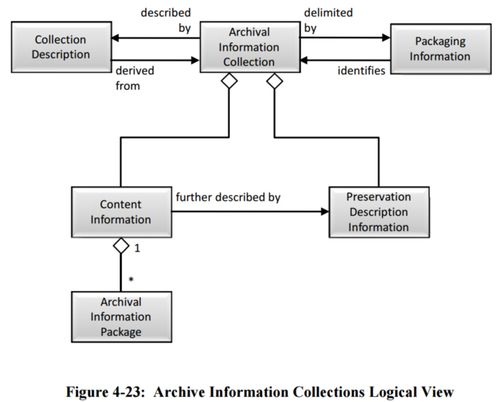4.2.2.7 Archival Information Collections
Community Forum | OAIS Community | OAIS Structure | OAIS Blog Posts | Active Topics and News
The AIU and its associated Unit Description provide the information necessary for a Consumer to locate and order AIUs of interest. However, it can be impossible for a Consumer to sort through the millions of Unit Descriptions contained in a large Archive. This problem is addressed here.
The Content Information of an AIC is composed of complete AIPs each of which have their own Content Information, PDI, and associated Packaging Information and Package Descriptions. These AIPs are then aggregated into Archive Information Collections (AIC) using criteria determined by the archivist. Generally AICs are based on the AIUs of interest having common themes or origins and a common set of Associate Descriptions. At a minimum all OAISes can be viewed has having at least one AIC which contains all the AIPs held by the OAIS.
For example, the OAIS for digital movies may have AICs based on the subject area of the movie such as mystery, science fiction, or horror. In addition the Archive may have AICs based on other factors such as director or lead actor.
A logical model of an AIC is shown in figure 4-23. As in the previous subsections, all of the containment relationships are logical containment and may be physical or may be accomplished via a pointer to another object in storage. For example, the Content Information of an AIC can be created either by creating physical collections of the contained AIPs or by pointing to the contained AIPs. A single AIP can belong to any number of AICs.
Figure 4-23: Archive Information Collections Logical View
For example, a pattern recognition technique might be created for digital movies and the OAIS for digital movies might offer a service to search its Archives for large structures such as the pyramids or a New York skyline. This type of service is very processing intensive, involving potentially large numbers of AIUs to be transferred from Archival Storage to Access and then running the appropriate process to analyze the Content Information from each AIU. If the results are generally useful, the archivist could summarize the results of this ‘content based query’ into an Associated Description of a new AIC that contains movies with large structures. This technique is frequently referred to as data mining.
An important feature of the AIC, as shown in figure 4-23, is the fact that an AIC is a complete AIP which contains PDI. The PDI provides further information about the AIC such as Provenance on when and why it was created, Context to related AICs, the desired level of security/Fixity and Access Rights Information. This is in addition to the PDI contained in member AIPs. This type of information is often necessary for a Consumer to have confidence in the reliability of an AIC. In the above example, the usefulness of the AIC of movies with large structures is to some extent based on the algorithm used and the Provenance of when the AIC was created or last updated.
--Please retain original text above for reference. Propose amendments or additions below this line or respond using the Discussion tab above--
Community Forum | OAIS Community | OAIS Structure | OAIS Blog Posts | Active Topics and News
These wiki pages are licensed under a Creative Commons Attribution-NonCommercial 3.0 Unported License. Attribute as "Community forum for digital preservation and curation standards http://wiki.dpconline.org/". The content on this wiki represents the opinions of the author and not the Digital Preservation Coalition. This wiki is not associated with ISO, the OAIS Standard or the CCSDS.

